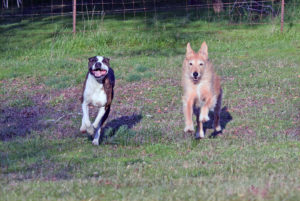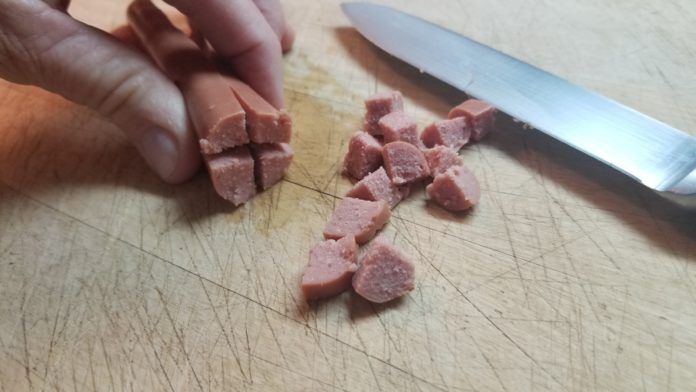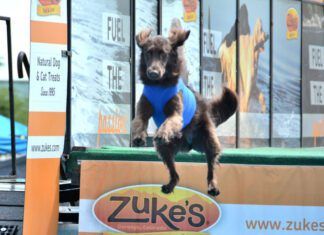Ask a dog trainer to tell you one of their biggest pet peeves about their training clients, and they will almost always mention the fact that the average dog owner almost seems to actively resist the concept of “high-value rewards.”
I’ve sat in on a lot of different trainers’ classes, and during the first session, all trainers make an effort to describe the treats they want to see their clients bring to puppy kindergarten and beginning dog training classes: extra-special treats, such as fresh meats and tiny cubes of fragrant cheeses. Extra-high-value treats are needed, it is explained, because the group-class environment is so exciting and distracting to the dogs and puppies who are new to this, that the owners will need reinforcers of the highest value to the dogs, to capture and hold their attention in a highly distracting environment. (A training center can also be very stressful for shy, undersocialized, or fearful dogs.)
I’ve heard trainers go on and on, for 10 minutes at a time, about the need for really succulent foods to be used as treats (not just dried treats or kibble, no matter how food-motivated the pup or dog is at home), not feeding the dogs before class (so the pup won’t be full of food already and unable to physically eat much more), cutting the treats into tiny bits (so many of them can be fed in a class), including a variety (not just one type, so the dog doesn’t get bored), and bringing more than the owner thinks she might possibly need, because you will be using many, many tiny treats in a 50-minute beginning dog-training class.
Trainers make such a fuss over the value and type and variety and amount of treats because, again and again, owners arrive to class and are shocked—SHOCKED!—to discover that:
- Their dogs are too distracted or stressed to take any but the most over-the-top delicious treats in the class setting.
- Their dogs completely disregard the owners’ pouches full of cut-up hot dogs and, instead, go bananas for the trainer’s samples of stinky cheese, tuna bits, roast beef, and freeze-dried liver.
- By the end of the class, when the trainer is saying, “Yes! That was great! Mark and reward that behavior!” and the owners often reply, “But I’m out of treats!”
To defend their choices, almost all owners will say, “But he works for kibble at home! I thought hot dogs would be ‘high-value’ enough! And I cut that hot dog into 20 pieces!”
(For what it’s worth, when I use hot dogs as training treats, I cut each one into about 64 pieces: Slice them lengthwise, roll it over halfway and slice it lengthwise again, so you have four long, skinny pieces. Then, holding it together, slice it across, about 16 times, so you end up with 64 or so tiny treats.)
By the end of a six-week class, though, any trainer worth her salt should be able to peek in every student’s bait bag and see a wide variety of scrumptious meats and cheeses and treats, all cut into tiny bits. Success!!
The best and highest-value treats
One of the main points that trainers will make during their first-class discussion is that owners should be prepared with a toy or food treat that is THE MOST valuable to the dog, for reinforcing behaviors that are particularly difficult for the dog, or for when the dog performs extraordinarily well in the face of a particularly difficult distraction.
I recently got a great reminder of how well it works to use especially yummy treats for behaviors that are especially critical.
I used to bring the dogs with me to an office about five miles from where I live; we drove into town most mornings. Last September, my husband and I completed construction of a small outbuilding on our property and then sold the house in town that I had been using as an office (and renting rooms to students) for the past eight years or so. Since then, the dogs and I commute about 50 yards from my back door to my new little office building. It’s great! And I love the new routine—with the exception of how it sometimes clashes with the routine of one of our neighbors.
We’ve been having an ongoing issue with a guy who lives up the road and walks his dog past my property every morning. For what reason, I do not know, but he stops at a certain spot by the fence in my front yard every day without fail, fishes a treat out of his pocket, and feeds it to his dog. And then he stands there for a minute or two, just hanging out. (We’ve introduced ourselves. He’s not just hanging out because he wants someone to talk to because sometimes he is chatty and sometimes he’s not. He sometimes will indicate he is listening to something with his earphones and just wave.)

I don’t know whether it’s just the fact that he stops there (instead of walking or jogging or biking by, like most people do, unremarked upon by my dogs), or something about his dog, the treat-feeding, or the guy himself, but when my dogs are outside and they see him coming along down the rural road I live on, they immediately start barking and run to the fence. Something about his walking/stopping habit drives them nuts.
If no one were to respond to them, my dogs would undoubtedly run, barking, along every inch of the 600 feet or so of the fence line that the guy walks by. But this is a behavior I can’t live with (and don’t want them to practice), so the dogs are never outdoors without someone being alert and ready to call them back to the house at the very first bark we hear. I’m telling you, I don’t so much as step into the bathroom in the morning without calling the dogs indoors first—that’s how much I don’t want them to have a chance to practice charging toward the fence!
On the days that they happen to be outside when “the guy with the dog” comes along, I always call them in, and then give them something to reinforce their prompt response. Sometimes I have treats handy, but sometimes I might have to look in the fridge for some cheese or something. They have even gotten just plain old kibble a time or two.
But after we reviewed canned dog foods for the December issue, I had a small mountain of cans of delicious foods on hand. And if I heard the dogs alert, I whistle or call them, and run for the canned food stash. It didn’t take them long to learn to run from wherever they are on our two acres to where I am in less than the time it takes to pop the lid off a can when they hear one of my two recall cues. And their recalls were already pretty prompt! A consistent super reinforcer has resulted in a super duper recall. Best yet, now, though they still let out a few woofs when the see “the guy with the dog” coming down the road, they usually woof as they run to find me and my super high-value canned food reinforcer. This stuff really works!







Thank you for this article (I, too, thought cut up hot dogs were good), but I am confused. What, specifically are the best and highest-value treats? What high-value canned food reinforcers do you recommend (or can you tell me how to choose?)?
Hi Connie, good questions! I recommend buying and trying lots of different things, and holding little “taste tests” so you can learn what your dog responds most strongly to. Put a few bites of fresh roast beef in one hand, and some canned chicken in the other. Offer one closed hand, and then the other, to your dog so he can sniff and investigate what’s in each hand. Then, either step back or ask him to sit, and open both hands at the same time, making note of which treat he goes for. Switch the treats in each hand for a few trials, and also compare the winners against other candidates. You may find your dog has a strong preference for one type of treat over another that you were sure he LOVED! Or, you might discover that what he really likes is variety; some dogs choose the “new” treat in each trial. In this case, you’d want to make sure you had a variety of treats in your arsenal for every training session.
And, I’m sorry for the confusion: When I said “this stuff works,” what I meant was, using the highest-value treats works for reinforcing the behaviors that are most important to you to achieve. My dogs think canned food is better than ANY other treats, so it doesn’t even really matter which can I reach for.
I feel your comments towards using hot dogs pretty condescending, honestly. I used hot dogs during my dog’s first training classes and they worked extremely well AND were high value BECAUSE we had never treated her with them before. For her, it’s about having new treats, or treats she hasn’t had in so long that she forgot she liked them. She’s also extremely picky in general, so I put a ton of thought and care into what we bring for her… so the last thing I need to worry about is what my trainer is judging me on. It’s pretty disheartening to hear that trainers can be so judgmental.
The highest value treat is what your dog considers to be the highest value – on that day, in that moment. That is why trainers suggest trying lots of different options and to bring a variety of treats to class since hot dogs may be the highest value today, but tomorrow it might be cheese or chicken or even liver flavored treats.
Turkey meatballs. But. The. Basic. Type. .. flavors. Can discourage. Their. Choice. . Clients. ,Attending our classes soon discover their benefits when. attention Is necessary during class exercises
Great article about high value rewards! As I was reading it, I had a thought…maybe the guy walking his dog stops and has his dog sit in front of your property to practice his own dog’s obedience around barking dogs?
Donna, I too had the thought of the stopper doing his own training. If it were me, I would have advised the property owner of my training intent and get a confirmation before continuing
HI Nancy,
I struggle with this because my cockers are invariably on very limited diets due to food sensitivities. I try desperately to keep them on their protocol because the result of off -diet food can be diarrhea, inflammation and allergy flares that can lead to ear infections. I try to use treats or kibble that are within their dietary limits. Some of my pups can enjoy fresh veggies, but others can’t. I wish I could use stinky cheese or roast beef! I am sure my pups would be a lot more motivated and focused!
HI Diane,
I too struggle with the notion that every pup should have high-value treats and especially in training classes. My first Irish Wolfhound puppy had such a sensitive stomach that he had liquid diarrhea during his puppy kindergarten class after the trainer gave him freeze dried salmon and her assistant rewarded him with cheese. He was fine and happy and able to consistently do all that was asked of him during class with just using kibble or small dry biscuits.
I too have this exact same problem. All three of my bassets have food allergies and two have extremely sensitive stomachs. Unfortunately, they also demand high value treats. I have had some success with dehydrating at home treats I know are safe. This was much easier when we had a local butcher shop that processed all their meat and did processing for the surrounding farmers. Then we moved. I am still searching for the same set up. I have found that they love sweet cherry tomatoes cut in half and dehydrated, and many types of fruit. But, my little girl holds out for meat. Any suggestions are welcome.
Hello Diane
It is indeed hard to have a variety of foods when a pup has an allergy and should not be eating certain things. You might try this and see if you see a difference, of course, check with your vet first to avoid any allergies or else from the experiment.
Put some of your dog’s kibble in a plastic container, drop in the container some high value food such as chicken (it could be dry chicken or fresh) if using fresh remove before it goes bad. Shake the container so that the kibble gets impregnated with the aroma of chicken. The sense of smell is the strongest in dogs not so much the sense of taste so if it smells like chicken or something meaty it might bring the “boring” kibble to a new level of interest.
The merest whiff of bacon turns most dogs into drooling bundles of attention! I’ve found in my classes that if people keep their bacon drippings in a jar in their fridge and just touch their treats to them, or grease a finger tip with it and touch it to the treats, it adds enough excitement but doesn’t cause any digestive problems.
Brilliant.
Wow! I am gonna try this.
We adopted a 2 year old 55 pound Boxer from the shelter 3 weeks ago. She has great manners in so many areas. She knows sit and stay and listens to commands well. She is very treat motivated. I have gone from store bought training treats to her kibble because it seems everyday she was getting the non-kibble treats she was throwing up at night. Nothing like a 4am wake up call to a dog wretching. She needs work on walking with a leash and the kibble is working fine as long as there are no major distractions. We live in a suburban area with nature walking paths shared by other dogs and people. She goes NUTS when she sees people or dogs and the kibble isn’t cutting it. What would you suggest to use and how do I know how much is too much for a dog with sensitivities? Is your suggestion of stinky cheese, tuna bits, roast beef, and freeze-dried liver things that you find are sensitivity friendly?
My moms airedale had severe pancreitis…could only eat the prescription diet….a lick on the finger of any other food set off a major reaction. So she bought the prescription canned….sliced and cut into pieces….froze and used those for treats. It worked since the dog ate dry kibble normally. Something about frozen canned (still prescription) worked. Just a thought!
We have a boxer that is reactive on leash, in a friendly way but it is still an unwanted behavior. Our trainer has also had us work with a special toy as a reward. So when there is a distraction and he holds his sit and does not react, he gets his toy for a bit. This is how we redirect and give his energy a way to get released.
For those with dogs who are sensitive to certain foods: You have to work to figure out which foods, precisely, they are sensitive to! Presumably, you are maintaining them on a diet that contains certain ingredients. I’d try fresh-food variations of those ingredients. So, if they were eating a beef-based food without a problem, I’d try to use roast beef or make little meatballs with beef. I would definitely stay away from store-bought treats, as they often have long, complicated ingredients lists; sometimes it’s a preservative or artificial color that a dog has a problem with.
All bets are off when it comes to dogs whose allergies are quiescent only when they are eating a kibble made with hydrolyzed proteins (such as Hill’s z/d, Royal Canin’s Veterinary Diet Hydrolyzed Protein, and Purina Pro Plan Veterinary Diets HA). If these types of diets are all your dog can eat without breaking out in terrible allergy symptoms, I don’t have much else to offer! Is anyone making treats with hydrolyzed proteins?
For more about feeding dogs with suspected or confirmed food allergies, see this article: https://www.whole-dog-journal.com/health/allergies/will-your-allergic-dog-benefit-from-a-food-elimination-diet/
My trainer chose to use “Praise only“ as reward. So far it’s working. I may need a high value reward for recall though. He just doesn’t listen!
Hi, Elisabeth–It’s not that your dog doesn’t listen when you call, it’s likely that his/her environment is more reinforcing than you are at the time. “Hmmm, would I rather keep trying to find the squirrel that was just here, or run to my owner for “good girl/boy?” That’s easy–it’s not worth it to the dog. It would be like you going to work some day and your supervisor says, “You know that paycheck thing we’ve been doing every other Friday? We’re not doing that anymore, but you do a fabulous job here and we’ll keep telling you that every day!” That wouldn’t be reinforcing enough for most people. Paychecks are reinforcing. It’s just not reinforcing enough for most dogs to come to you if all they get is praise. My dogs know when they coming charging towards me, that I have something fabulous waiting for them (warm tidbits of meat are the most exciting to them). Then, they get the best of both worlds and are told to “go free” and they get to go back to what they were doing . . . until I call them again.
Sometimes you can add water to kibble until it makes a paste and you can make little “meatballs ” out of them and bake them in the oven. It has a different consistency than dry kibble and can be seen as special form the dog’s point of view.
This was a great article. Which canned food seemed to work best? My mini doxie is very food motivated but it never hurts to have a back up. lol
High value treats…We have used pulled rotisserie chicken breast (Costco). Chunks of almost any cheese. Tiny pieces of cooked beef. The “better” hot dogs, i.e., all beef. Lunch meats. Keep the variety up.
This is silly.
You need a treat “of sufficient value”… when we were training a rescued bulldog how to UNLEARN bad behaviors, and listen, YES, we needed the highest value treats… freshly poached chicken (no seasonings) to get his attention.
My mastiff, on the other hand, happily works for bites of regular old dry kibble. Anything of much higher value, and she is totally distracted by the smells, and forgets to listen – she just jumps around (all 160lbs of her) trying to get to the treat.
If I offered a 1/64th piece of hot dog to her, I would lose my hand, as that bit would be completely invisible to her. Might as well use a “lick-stick”.
Know Thy Dog.
Agreed about “sufficient value”! Sometimes, you may even need to lower the value of the reinforcer, if the dog is food-obsessed. And of course, if you have a giant dog, treats of a larger size will be appropriate. A lick-stick works great in many cases! I tell older people with small dogs to smear peanut butter or cream cheese on a wooden spoon, and lower it to allow the dog to get a quick lick as a reinforcer. Those squeeze tubes used for camping are great for this, too. Fill them with a smooth canned food and squeeze a bit out, allowing the dog to lick it from the end of the tube.
So agree TinaT, “Know Thy Dog”, that is the best wisdom, and love what you shared Nancy Kerns.
I have a beagle mix who is now six years old. We rescued, or he rescued us at the tender age of 6 months old. After several training classes, trainers, reading tons (I needed it as he is my first dog as an adult), “Know Thy Dog” is truly the best wisdom. Experiencing what I have with my lovely hound, hindsight being the great teacher, I personally would cut back on treats as a whole, high value or not, and focus more on positive re-enforcement and connecting with ones dog, which we are currently doing. I feel and have seen food motivated dogs can become a bit obsessed with treats, though sometimes it is the only way to get their attention. Life is chock full of experiences and lessons. I’m not an expert by any means, though living in NYC near Central Park, a dog utopia in and of itself, I have witnessed, observed and experienced a ton. What I have come to, is, yes, know thy dog, know thyself, get some wise training yet trust your intuitive guidance and do the best ya can. We are all similar yet different, and with love and patience we discover what works best for our individual circumstances.
I have finally found something of high enough value for agility training class, so that my girl will come back to me, instead of racing out of the tunnel over to the other dogs in class. Pork Rinds! And puff cheese balls. But, since the cheese balls are a mess to handle and not so great for them, I prefer the puffed rinds. Has to be amazing to get her back to me!
I was in a training class and one couple of Beagle owners brought cheese cubes that were the size of dice. They were packaged human snack cubes! The dog got one whole cube each time. Not only did they run out of treats, that dog was probably pretty uncomfortable for a couple of days!
With regards to using hot dogs, pre-made frozen meatballs, etc., what about the onion and garlic powder content? I know trainers who use processed foods that contain onion and garlic powder (aka concentrated alliums). The response I usually get when I bring this up is “it’s not enough to hurt them,” but from some research I have read that the toxic compounds can build up and cause serious health problems. I am not vet or health expert. Does anyone have any further information on this? I usually just make my own training treats from chicken, or I make my own dog-friendly meatballs. Am I over-worrying or is this a real concern?
I would always favor home-made training treats to store-bought, because we know precisely what’s in anything we make. If buying something commercially made, I would choose products without strong seasoning. I doubt there is enough garlic or onion to be problematic for medium or large dogs, but very small dogs? Better safe than sorry.
Interesting that you mentioned changing the treats. I have a Beagle who will eat any and every thing available. He never refuses any treats, but if I want his best performance in a sport, I change the treats. This applies to all sports and he does 8 different canine sports. Sometimes, I do need to use kibble to calm him down a bit. He has been known to offer behaviors and go crazy for prime rib and salmon. Those I save for obedience jackpots because that behavior is high value for me. 😉
LOVE, LOVE, LOVE THIS ARTICLE!
Every word, true.
Sharing!
I had someone in a puppy class feeding a Pug with large treats that were bigger than I would feed my adult Kerry Blue terrier! I think this is especially important when you consider how many Pugs are obese.
I think the variety of treats is important too.
My dog got sick from high value treats during class. He was pretty motivated with regular treats. But when he is distracted by more than one stimuli, the preference to bark furiously at the neighbor dog or as happened a few times, took off on me, no level of treat was enticing enough.
I use a lot of food R+ in training so I make my own nutritionally-dense treats in bulk. I combine 10+ lb of meat and bone with organ meats, eggs, and vegetables, grind it, and bake at a very low temp until mostly dried but still soft. Very inexpensive and nutritious, compared to store-bought treats or hot dogs.
Kim – your recipe sounds great! I make a similar recipe to feed raw, but I like the idea of making (and handling!) baked treats. Do you make a “meatloaf “ type, or a looser crumble in a shallow pan? Or?
Please share
The author makes a common mistake thinking that what works for their dog(s) means it’s a rule for all dogs. Dogs vary so much based on breed, personality and their experience, that these “easy rules for dogs” just don’t work. I’ve had dogs that would work for any treat, or no treat or very specific “succulent” treats. There are no easy answers — just work with your dog and realize that some are smarter than others and some have preferences and some just love “any” food.
I have had several dogs who simply would NOT ‘work for food’. Toys, games and life-style rewards worked best. In fact with my Working Kelpie. I need to play ‘fetch with his bone for quite a while before he would decide to actually eat it. If I offered this dog any treat during training, he would spit it back out at me. I did get him to actually swallow treats by rewarding him for eating with a ball fetch. The trouble was if we were doing agility, he would promptly vomit up the treats when he began working.
Another dog would politely take the treat from me and then spit it our when I was not looking — NOT good in class!!
After over 20 dogs, I finally have one that prefers food treat to anything else. Beagle/English Cocker mix, but even she is happy to work for games :-). Not my choice, I prefer stock and sheep dogs 🙂
Don’t forget the value of a good game of tug. Most of my dogs are very foodie but one, it given a choice will choose the tug every time. I still use food for him, depending on the situation and level of arousal, but it comes down to knowing your dog.
what is the cost of a dog’s DNA test
I started using a recommended book (by you), Feisty Fido, which dealt with treating dogs on a leash when there were behaviors that needed to be changed. The “guy with the dog” might have the same issue I did. I could not walk peacefully by a house with a dog (much less see an actual dog) because one of my dogs (a terrier, go figure) was so reactive to a barking dog, he went nuts. So I starting treating him and now, if he hears or sees a dog, he turns to me for a treat. Maybe the guy with the dog read the same book, and he’s treating his dog for not responding to yours!!
This is very interesting and I will now start using high valued treats. It seems that they work.